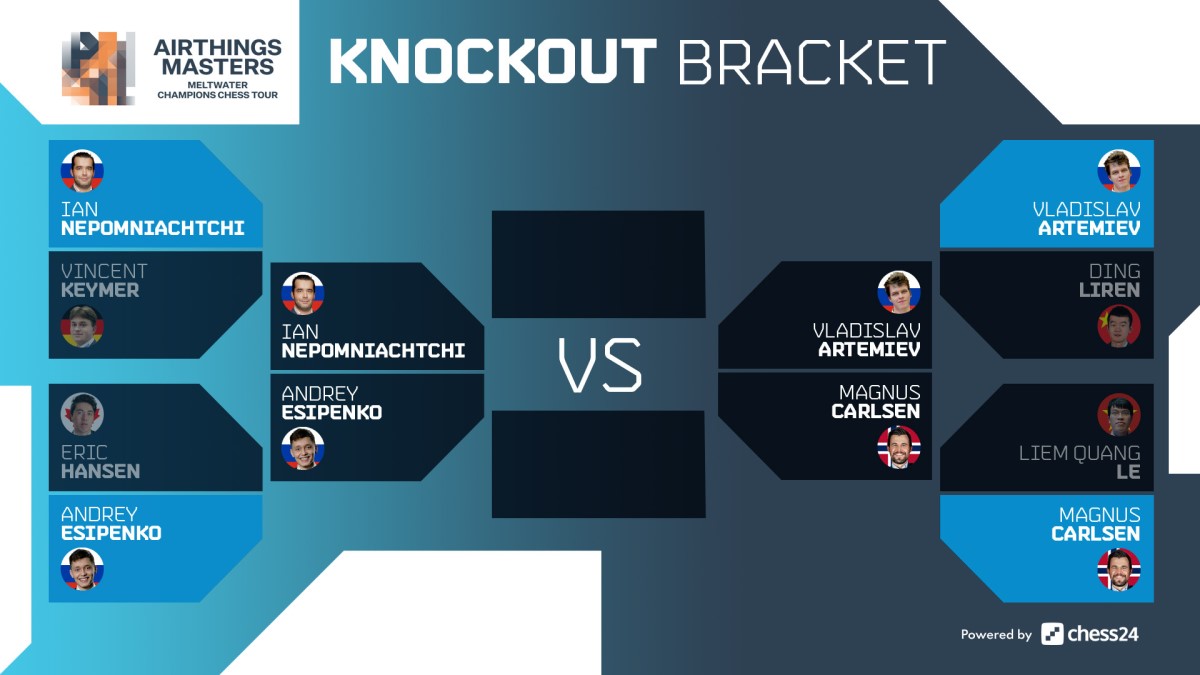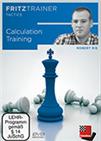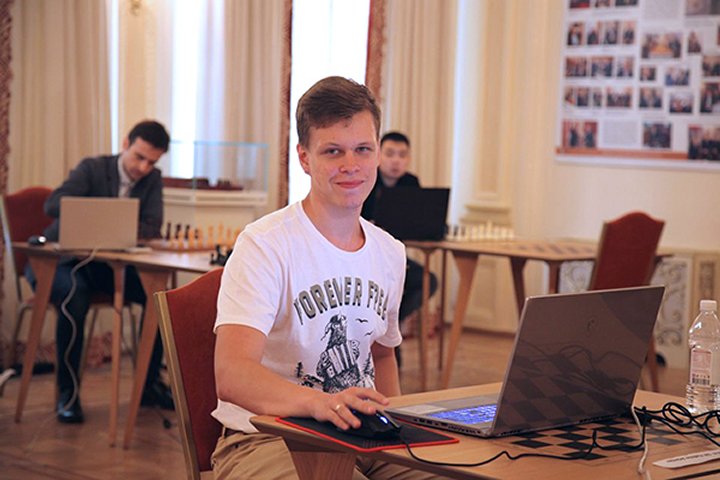No tiebreaks needed
 None of the four quarterfinal matches of the Airthings Masters were decided in blitz tiebreakers, as Magnus Carlsen, Ian Nepomniachtchi, Andrey Esipenko and Vladislav Artemiev all claimed tickets to the semifinals after winning their 4-game rapid encounters.
None of the four quarterfinal matches of the Airthings Masters were decided in blitz tiebreakers, as Magnus Carlsen, Ian Nepomniachtchi, Andrey Esipenko and Vladislav Artemiev all claimed tickets to the semifinals after winning their 4-game rapid encounters.
The one player who knocked out a higher-rated opponent was Artemiev, as he got a 2½-1½ victory over Ding Liren. For the Chinese, it was a rather painful defeat, not because he was facing a nominally weaker player, but because he was inches away from becoming the first player to reach the semifinals.
 When it comes to strategy, one of the key things that chess professionals understand much better than amateur players is the role of the bishop which is the key theme on this video course.
When it comes to strategy, one of the key things that chess professionals understand much better than amateur players is the role of the bishop which is the key theme on this video course.Ding had a 1½-½ lead going into game 3. Playing white, he garnered a winning advantage in a difficult tactical position. Amid the complications, though, not only did he lose his edge but also saw his opponent get the upper hand and eventually claim the win. Artemiev had the white pieces in game 4, and went on to score a 38-move victory to gain a spot in the semis.
As we mentioned in our day-1 report, Ding played the online tournament from China, which means that each day’s first round kicked off at 1 in the morning for him. Vidit Gujrathi emphasized this fact while feeling sorry for his colleague on Twitter:
After knocking out the third highest-rated player in the world, Artemiev will have the tough task of facing the world champion in semis. In the other matchup, Nepomniachtchi will face Esipenko in an all-Russian confrontation.

Artemiev 2½ - 1½ Ding
In the crucial third game of this matchup, Ding failed to find a way to break through from a clearly superior position.
Ding’s 29.Qxb7 does not give away all his advantage, but this is the first time he missed the killer 29.Nxf6 — the idea is that after 29...Nxf6 there is 30.Qf7 threatening mate on g7, and Black is completely tied down to defend mate after 30...Rg8.
Apparently, Artemiev also failed to find this blow, as his 29...Rg8 (instead of 29...Bc7) gave White another chance to grab the pawn on f6. However, Ding had not seen the line before and did not see it now. Moreover, his 30.Rde1 was a losing mistake. Artemiev quickly invaded his opponent’s camp with 30...Rc2.
Black’s rook and bishop are aiming at h2, and White has no effective defence against 31.Rxe4 Rxh2+ 32.Kg1 Rxh6.
White is no longer winning, but the position is still messy, especially for a rapid game in which both players came from calculating long lines for quite a while. After 33.Rxf6, Artemiev’s 33...Rh3 was in fact a mistake, but finding the refutation was not easy at all.
Ding surely knew he had missed a big chance to win the whole match, and apparently was not able to recover psychologically, as he lost both this game and the next.
Nonetheless, kudos are due to Artemiev, who showed great tactical alertness while coming back from behind.
Select an entry from the list to switch between games
Esipenko 3 - 1 Hansen
The lowest-rated player that reached the quarterfinals had to contend with another young, tactically sharp Russian opponent. After draws in the first two games, Esipenko gave up his queen for positional compensation.
 This DVD emphasizes the importance of training your calculation skills. Dutch IM Robert Ris made a selection of training material which he uses in lessons with students ranging from 1400 to 2400.
This DVD emphasizes the importance of training your calculation skills. Dutch IM Robert Ris made a selection of training material which he uses in lessons with students ranging from 1400 to 2400.
The material imbalance that appeared on the board after 22.Bxd6 Bxd5 23.Bxf8 Qxf8 24.cxd5 signalled that a dynamic battle lied ahead.
A few more simplifications clarified the situation, with White getting an annoying passer on the d-file and a well-positioned blockading knight.
Perhaps Hansen would have been able to hold this position in a classical game, but the dynamic chances White has here with the pair of rooks and the passed pawn are difficult to handle in a rapid encounter.
Esipenko slowly but surely created the appropriate conditions to push his pawn to the seventh rank. With the passer one step away from queening, Hansen resigned on move 48.
Nepomniachtchi 2½ - 1½ Keymer
The latest challenger to the world crown was both the first to secure a spot in the knockout and the first one to win his match in the quarterfinals. Nepo showed good technique to convert a superior endgame into a win in the one decisive game of the match.
White soon grabbed his opponent’s a-pawn and activated his king via e3-d4-e5-d6 to support his passer on the c-file. Resignation came on move 58.
Carlsen 2½ - 1½ Le
Much like Nepomniachtchi, the world champion kept things under control throughout his quarterfinal match. Carlsen won game 1, safely drew the following two encounters and agreed to a draw from a winning position to secure a spot in the semis.
 Let our authors show you how Carlsen tailored his openings to be able to outplay his opponents strategically in the middlegame or to obtain an enduring advantage into the endgame.
Let our authors show you how Carlsen tailored his openings to be able to outplay his opponents strategically in the middlegame or to obtain an enduring advantage into the endgame.
Black could have gone for the devastating 29...Nh3+ 30.Kh1 Rxg2 here, when White would need to give up material to prevent a mating attack. Carlsen, however, decided to call it a day and agreed to a draw.
Talking to the commentators afterwards, the world champion referred to the online rating implemented by the organizers in this year’s series:
I have not come to value the tour rating that high that I’d forgo absolute certain qualification to go for more (smiles).
Links


















 None of the four quarterfinal matches of the Airthings Masters were decided in blitz tiebreakers, as Magnus Carlsen, Ian Nepomniachtchi, Andrey Esipenko and Vladislav Artemiev all claimed tickets to the semifinals after winning their 4-game rapid encounters.
None of the four quarterfinal matches of the Airthings Masters were decided in blitz tiebreakers, as Magnus Carlsen, Ian Nepomniachtchi, Andrey Esipenko and Vladislav Artemiev all claimed tickets to the semifinals after winning their 4-game rapid encounters. 





